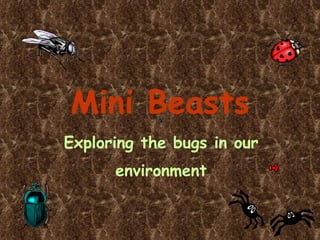
Exploring Mini Beasts
- 1. Mini Beasts Exploring the bugs in our environment
- 2. Ants Ants like to live in big groups Ants eat plants and other insects The queen ant lays all the eggs Flying ants only fly when it is warm and humid
- 3. Woodlice Woodlice are not insects, but crustaceans They eat leaves, grass mulch and rotten wood They role up in to a ball when they feel threatened They live in damp places
- 4. Stag Beetle The Stag Beetle is the largest British insect They live mainly in rotten wood The larva live for 3 – 5 years but the adult beetle only lives from May - August They eat small insects
- 5. Worms Worms are both sexes Worms will eat most rotting plants Gardeners love worms because the add air to the soil A worm does not have any bones
- 6. Spiders are not actually insects because they have 8 legs Spiders are called arachnids Spiders produce webs and use these to catch their prey. The spider silk is very strong and very fine. Spiders eat flies and other small insects
- 7. Ladybirds Most ladybirds feed on aphids, whitefly and mealy bugs. The bright colour of their body is to scare away predators. When they are disturbed, the ladybird will discharge drops of yellow, bitter, smelly liquid from their body. Adult ladybirds hibernate through the winter. They lay their eggs from late spring to early summer. The larvae hatch from the eggs. They then start to eat lots of aphids. After three weeks the larvae attach themselves to a leaf and form a pupa. After about two weeks the ladybird appears out of it. Ladybird larvae
- 8. Chrysalis (pupa) Caterpillars and butterflies These start life as an egg on the underside of a leaf. The egg hatches between three and twelve days later. The caterpillar then starts to eat leaves and gradually grows to full size over two weeks. The caterpillar will then attach itself to a twig head down and change into a chrysalis. This takes a few hours. About two weeks later the chrysalis begins to open and a butterfly emerges. The butterfly has to wait for its wings to dry and stiffen before they can fly.
- 9. Bees Bees are flying insects. Their home is called a hive. They have two sets of wings. The male bees are called Drones. They live in large groups called colonies. They collect nectar and pollen from flowers using their proboscis( a long tube from the mouth). The Honey bee flaps its wings over 11000 times per minute.
- 10. Earwigs The earwig mainly comes out at night. In the day they hide in dark crevices. They mainly eat plants, but sometime eat other insects. Earwigs have wings but rarely use them. The female earwig lays 20 –30 eggs. When they hatch she feeds and tends to them until they can look after themselves. You are most likely to see them from the spring through to the autumn.
- 11. cockchafer Cockchafers are found mainly in woodland, farmland and gardens. They are usually seen flying around from May through to July. They have a three year life cycle. 10-20 eggs are laid in the soil (about 20cms down). After 20 days they hatch and the larvae remains in the soil for two years. They feed on the roots of plants. When they are about 5cm long they pupate in the soil. In the autumn they change into a cockchafer, but remain in the soil until the following Spring. They will then come to the surface . Larvae
- 12. The End